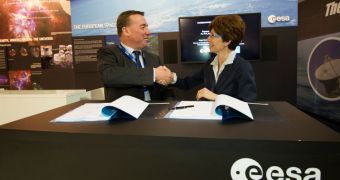On Tuesday, July 10, representatives from the European Space Agency (ESA) and Avanti Communications, a UK-based company, signed an agreement that stipulates the terms under which a new ESA satellite will carry a private communications payload into orbit.
The payload is developed by Avanti and will be included on one of the space agency's upcoming European Data Relay System (EDRS) satellites, to be launched in 2014 and 2015, respectively.
The agreement was signed at the 2012 Farnborough International Airshow, currently being held in England. The document says that Avanti and the private-public consortium managing EDRS (made up of ESA and aerospace company Astrium Services) will share the costs of the satellite.
The Hylas-3 communications package will be included on the second EDRS spacecraft, which is scheduled to take off sometime in early 2015. A clear launch date has not yet been set, experts say.
The EDRS, as a system, is made up of two payloads, each of which will travel to a geostationary orbit some 36,000 kilometers (22.370 miles) above the surface of the planet on its own spacecraft.
According to ESA, the main purpose of the new system will be to receive and centralize data collected by other spacecraft, located in lower orbits around the planet, and then relay them to ESA ground stations, for processing and redistribution.
The first satellite to contain an EDRS payload is Eutelsat-9B, which will launch in late 2014, and will be located in a stationary orbit at 9°E over the Equator. The spacecraft is now being built by Astrium.
The name of the second satellite to carry such a payload has yet to be revealed, but ESA officials say that the Hylas-3 communications package was offered a spot onboard because there was still some room left.
“Through this arrangement, the cost of satellite resources and the launch are now shared. This contributes to the funding of the EDRS program while providing access to space at a lower cost for the hosted payload,” ESA says in a press release.
“The EDRS payload includes a laser terminal developed by TESAT of Germany to transmit up to 1.8 gigabits per second over distances in excess of 40,000 km [24,850 miles], between the lower satellites and EDRS in geostationary orbit,” the agency adds.

 14 DAY TRIAL //
14 DAY TRIAL //